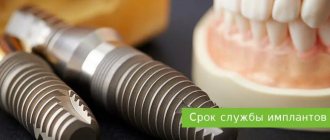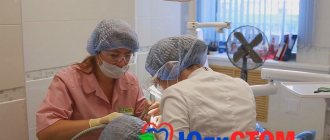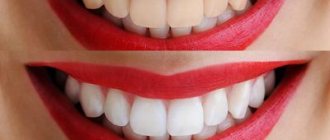Author of the article: Gadzhiev Ruslan Abasovich
Doctor-expert
Specialization: Dentist-therapist
Total work experience: since 2011
Reading time: 7-8 minutes
Tooth decay in general, and crumbling in particular, is not an aesthetic problem. In some cases, decaying teeth can be the result of not only dental, but also other types of diseases. To understand the topic and know why teeth crumble, what to do and which doctor to contact, you need to study all the important details.
Why teeth crumble - the main reasons and factors
Various types of tooth decay can be influenced by natural, mechanical and other factors. Sometimes this is a consequence of the neglect of some dental problem, and in other cases it is the result of the appearance of common diseases. Conventionally, all factors that can cause tooth decay are divided into three groups:
- External
:- Mechanical impact
. Strong clenching of the jaws, biting off hard objects, injuries - this is not a complete list of reasons that can lead to mechanical injury to the teeth. If the result is a violation of the integrity of the enamel, then the risk of not only the development of infections, but also the appearance of deformation increases. - Temperature
. The temperature of the foods you eat directly affects the condition of your teeth. Excessively hot or very cold dishes lead to the appearance of microcracks through which pathogenic bacteria penetrate, causing destruction/crumbling. - Chemical exposure
. Concentrated chemicals negatively affect the health of enamel. For example, its protective properties are significantly weakened by regular consumption of sour citrus fruits. - Improper oral hygiene
. This can be either individually incorrectly selected teeth cleaning products or irregular hygiene procedures. As a result, there is an accumulation of microbes that are destructive and will inevitably cause a number of diseases, including gums. - Domestic
:- Bad heredity
. Unfortunately, this is one of the factors that cannot be controlled. The tendency of teeth to decay, for example, due to thinned enamel, can be inherited and manifest itself at any period of a person’s life. The main task in this case is to slow down the destruction processes and focus on preventive measures. - Unbalanced diet
. In this case, a real chain reaction is triggered - the lack of a well-structured diet leads to metabolic disorders, resulting in a lack of useful vitamins and microelements necessary to strengthen the gums and enamel. As a result, for example, if teeth crumble, the reasons are a lack of fluoride and calcium and, as a consequence, thinning of dentin. - Hormonal instability
. Disruption of the endocrine system is one of the reasons for the development of caries, and its appearance is the first step towards tooth destruction. - Regular use of drugs
. Some therapeutic procedures and medications reduce the intensity of saliva production, which, accordingly, leads to negative consequences. - Chronic diseases
. Weakened immunity, for example, due to diagnosed oncology, hypertension, gastrointestinal disorders, etc. always negatively affects the condition of the teeth. - Vitamin deficiency
. To maintain healthy teeth, gums and the oral cavity in general, a person must consume sufficient quantities of vitamins B, C, E and D. Their absence in the diet or the inability to fully absorb them can lead to crumbling. - Bad habits
:- snacking on foods with excess sugar (lead to the formation of plaque, which destroys the enamel layer);
- biting third-party objects, for example, a pen/pencil, thread, wire, etc. (leads to mechanical damage);
- bruxism (night grinding of teeth leads to their abrasion and destruction);
- frequent consumption of drinks that affect enamel pigmentation (for example, coffee, red wine, carbonated drinks with artificial food colors);
- frequent whitening using folk remedies (increases sensitivity, has a detrimental effect on teeth in general);
- smoking (weakens the immune system and reduces the absorption of vitamins, which can cause vitamin deficiency).
The reason why teeth crumble may be one or several of the factors listed above. Be prepared that in order to solve the problem you will have to contact not only the dentist, but also reconsider your lifestyle, nutritional culture and oral hygiene habits.
Chronic diseases
The main disease is caries. If left untreated, the tooth will collapse, as the superficial lesion gradually penetrates deeper, reaching the nerve. They can also get sick and deteriorate in the presence of certain chronic diseases:
- Diabetes mellitus provokes the development of periodontitis, which causes premature tooth loss and destruction of the jaw system. In diabetes, mineral metabolism in the body is disrupted, fluoride and calcium are washed out of it, and their deficiency leads to thinning of the enamel. As a result, bacteria quickly penetrate inside the tooth, destroying it.
- Osteoporosis affects not only the spine, but also the jaw bones on which the teeth are attached. The disease develops due to a lack of calcium, which is the main element in the structure of the skeletal system. Osteoporosis destroys periodontal tissue, causing gum disease, making gums soft and exposing tooth roots where bacteria can easily penetrate.
- Hypertension, for the treatment of which drugs that cause dry mouth are often prescribed. As a result, pathogenic microorganisms are not washed off by saliva, actively multiply, penetrating microcracks in the enamel, and increase the risk of caries.
- Gastritis with high acidity, changing the qualitative composition of gastric secretions and disrupting the absorption of phosphorus and calcium from it. Their deficiency leads to a decrease in the strength of the enamel.
The curvature of the spine also has a negative impact, which can provoke improper closing of the jaws, which leads to loosening and wear of teeth. It negatively affects the condition of the oral cavity and impaired metabolism, due to which the body does not receive the required amount of vitamins and microelements.
Diagnosis and identification of the cause
Teeth crumbling is a consequence, but only a specialist can determine what the root cause is. It will take one or more appointments (depending on whether additional tests are required) to understand whether dental or some other reason led to the appearance of crumbling.
The diagnostic examination takes place in several stages:
- examination of the patient’s oral cavity to collect a detailed medical history;
- if the reason is not dental, then a recommendation is given to visit a doctor according to indications, for example, an endocrinologist, therapist, gynecologist, etc.;
- a referral is issued for blood tests (to identify possible pathologies, such as anemia, hormonal disorders, etc.).
Often, x-rays, ultrasound and other tests may be required. The more thoroughly information about your health status is collected, the higher the chance that the cause of tooth decay will be eliminated and it will be possible to save those that are not yet affected.
You might be interested in:
Online consultation
Dental restoration
Treatment of caries
Cervical caries
What to do when the process of tooth decay begins
Modern dentistry is not about pain at all. This is about caring for the patient and the desire to preserve his teeth.
Dentists' advice is simple, but how many people follow it?
How to prevent teeth from rotting:
- Lead a healthy lifestyle
- Takes good care of your teeth
- Carry out hygiene procedures regularly
- Monitor your general health
Plaque on teeth is the beginning of the decay process. Regular cleaning of tartar is one way to keep your teeth healthy.
What to do with already crumbled teeth?
Whatever the reason, but if the fact of crumbling has already happened, you need to worry about the issue of restoration. Dental procedures in this case can be carried out in parallel with the elimination of the cause of teeth crumbling.
Recommended options for restoring crumbling teeth:
- Artistic restoration or filling
. Suitable for cases where a small area is crumbled and the resulting cavity is not affected by caries. Photopolymer materials are installed in place of the missing piece of fabric. - Prosthetics
.
The appropriate option is selected individually. The dentist may offer you: Veneers
. If the destruction has affected only the front part of the tooth and is purely aesthetic in nature, a ceramic onlay will help correct the defect. - Crowns
. If the tooth has crumbled very badly, then crowns made of metal-ceramics, ceramics or zirconium dioxide can be used for restoration. - Tabs
. They allow you to restore the destroyed part by replacing the missing tissue.
. It involves the implantation of an artificial root into the bone tissue, on which a crown is then installed. The method is indicated for those whose tooth could not be saved, which led to its complete loss.
Only a dentist can determine the optimal method for restoring crushed parts, and already at the first examination. Please note that if the problem is not addressed immediately, it may worsen and lead to complete tooth loss.
Foods that harm your teeth
When we eat any food, do we often think about the health of our teeth? No, of course, there are moments of insight when we try to crack a nut shell with our teeth or remove the cap from a bottle, and that’s probably all. However, our teeth need the same care as any other part of our body, so we should not forget about their health. We invite you to learn about seven completely unexpected foods that ruin our teeth.
Surprisingly, sugar does not cause tooth decay. When you consume sugar, the bacteria that naturally live in your mouth also consume that sugar. But bacterial waste is acidic. Acid is what causes dental problems. The acid decalcifies or demineralizes tooth enamel, destroying its structure.
List of foods harmful to teeth
Dried fruits
For many, dried fruits have long become a useful alternative to various sweets. They do contain many vitamins and minerals, but they have a very negative effect on dental health. The fact is that dried fruits contain sugar, and the chewy texture of dried apricots, prunes and other dried fruits literally sticks this sugar to the teeth, causing the destruction of enamel and the formation of caries. To avoid this, try to brush your teeth after eating these foods.
Citrus
Another category of products associated with proper nutrition is citrus fruits and their juice. The high content of vitamin C supports the health of the body, but the acids that citrus fruits are rich in destroy tooth enamel. After you have eaten an orange or grapefruit, do not brush your teeth under any circumstances, otherwise you risk removing all the enamel. It is best to rinse your mouth with water and not eat anything for 20-30 minutes. This way the acid will have time to neutralize without causing harm to the teeth.
Saltine cracker
Saltine crackers are worse than candy when it comes to your teeth. Crackers are nothing more than fermented and processed starch. They also significantly increase the glycemic index, making food more cariogenic.
Cough drops or plain lozenges
The best sweets are those that you eat all at once. Sucking on candy means your teeth are exposed to sugar and acids much longer than if you ate a piece of cake.
Nuts and seeds
We recommend that those who already have dental problems be especially careful with nuts and seeds. Due to their dense structure, these products can cause teeth to chip and damage existing fillings and crowns. If you currently wear braces, then nuts and seeds should be completely excluded.
Coffee
Tannic acids found in coffee can cause more damage to teeth than candy. The acids that enter your mouth with your morning cup of coffee can destroy your tooth enamel. The longer coffee stays in your mouth, the worse the effect, so avoid frequent coffee breaks.
Carbonated drinks
It is better to completely exclude this category of drinks from the diet, because there is no benefit from sweet soda. And you shouldn’t believe that drinks labeled light are less harmful. They have the same negative impact on dental health as classic versions of the same drinks.
Prevention of tooth decay
Already knowing why teeth crumble, it’s easy to draw logical conclusions about what you should give up and what you should take up as a habit as preventive measures. But, in fact, the list of recommendations for well-organized prevention is quite large. The main tips concern the following issues:
- Professional cleaning
. It is carried out to remove plaque and stone. - Remineralization
. It is carried out with the aim of restoring and normalizing the balance of vitamins in the dental tissues. To saturate the tissues with the necessary elements, a special composition is applied to the surface of the tooth for several minutes. After enrichment with fluorine and calcium, the fabric becomes stronger. - Fluoridation
. The use of fluoride-containing pastes that actively nourish the enamel. It is fluoride that is responsible for crystalline calcium compounds and helps strengthen teeth. - Taking active supplements
. With a predominance of calcium and vitamin D. - Rejection of bad habits
. Both in nutrition and in other aspects, for example, refusing to bite your nails. - Revision of the diet
. Regular consumption of seafood, fresh vegetables, fruits and cottage cheese is encouraged. - Rinse
(with water or special compounds). Recommended after every meal and snack. - Routine visit to the dentist.
Even if you have no complaints, it is recommended to schedule an examination at least twice a year.
Also try to avoid stress and walk outdoors more often. In addition, it would be a good idea to consult with your doctor about choosing the toothpaste that is best suited for you. And also purchase a soft brush, rinsing compositions and floss for cleaning the interdental space. Their regular use will be an excellent prevention.
Protozoa
The decomposed cellular substrate in the organ is attacked by protozoa, which, processing this waste, act as garbage collectors in containers. Thus, dead cells, bacteria, and toxins are not just scattered throughout the organ, but cleaned, aligned cavities. This process is dynamic, each type of introduced microorganisms has time to become saturated and grow, multiply, that is, give birth to offspring.
The process continues until the immune system says: stop! It sends lymphocytes, leukocytes, macrophages, antibodies, sends energy and, depending on how well they cope, either recovery, improvement, remission (subsidence) occurs, or the disease turns into a sluggish chronic process. Protozoa are localized in the skin, eyes, tongue, intestines, liver, kidneys, bladder, genitals, etc.
Features of nutrition with increased fragility of enamel
If the problem of teeth crumbling is purely dental, then most often it is a consequence of thinning and brittleness of the enamel. If you solve the problem solely aesthetically, your teeth will continue to deteriorate. The most correct option is to follow the nutritional recommendations, observing two basic conditions:
- Normalize the functioning of the gastrointestinal tract (for complete absorption of mineral salts).
- Ensure the supply of essential minerals and vitamins from food and more.
Make it a habit to eat 5-6 times a day, eating small portions of food each time. Avoid foods that are difficult to digest and harmful (including processed foods).
Try to regularly consume foods rich in:
- Phosphorus
: eggs; - high-quality natural cheeses;
- nuts;
- sesame;
- pumpkin and sunflower seeds;
- greenery;
- seafood;
- beef and veal.
:
- fish (in particular sardines and herring);
To ensure the necessary chemical reactions, it is very important to consume clean water regularly and in sufficient quantities. For an adult, the norm is 1.5-2 liters per day.
Poor nutrition
Proper nutrition affects both the entire body as a whole and its individual systems, including preventing the development of dental diseases. The most dangerous is the unreasonable consumption of carbohydrates, namely sugar-containing products, and their significant predominance in the diet.
To maintain dental health, it is recommended to include foods rich in:
- protein (meat, fish, eggs, milk), since its deficiency has an unsatisfactory effect on the accumulation of calcium;
- fluoride (seafood, fish, buckwheat, radishes, carrots), the optimal amount of which increases the resistance of tooth enamel to pathological factors;
- calcium (cabbage, nuts, fruits, dairy products), which has a positive effect on the crystal lattice of teeth.
In order to avoid negative effects on the jaw system, you should limit the consumption of sticky, viscous foods - toffee, chocolate bars, liquid caramel.
Such food sticks to the teeth, is poorly washed off by saliva, and contributes to the development of caries. You should not abuse sweet carbonated drinks and packaged juices, due to the high sugar content in them.
Brief conclusions
If you notice that your teeth are crumbling, but do not experience pain, this is not a reason to delay going to the dentist. Get ready for the fact that the problem that has arisen will have to be solved comprehensively, turning to doctors of various profiles and solving not only dental, but also other health problems. If your teeth are crumbling, the causes can only be determined and eliminated by a specialist.
And most importantly, do not neglect preventive measures that will help maintain the integrity of your teeth and healthy gums.
The influence of sex life on dental health
Australian scientists from the University of Queensland claim that dental health depends on how satisfied you feel in bed.
In a series of experiments (a group of 265 people over 30 years old), it was found that people who are happy in bed pay special attention to their appearance, including oral hygiene. A harmonious personal life and a state of self-satisfaction make it possible to less often turn to dentists for dental care.
Read also
What is dental restoration
If the aesthetic properties of teeth are lost, a person experiences certain discomfort.
What to do if your tooth aches
Sometimes aching pain in a tooth can appear for no apparent reason at first glance.
Lifestyle and micronutrient deficiencies
To a certain extent, a person’s lifestyle affects the condition of their teeth. Thus, in people involved in certain sports (boxing, hockey), they are often injured, their integrity is compromised, a crack forms, and a crown or root fracture occurs. Because of this, the tooth becomes loose and its position in relation to the rest of the jaw changes.
A lack of vitamins and microelements causes hypovitaminosis, which is manifested by bleeding gums during the cleaning process. Most often, this happens in the winter-spring period, due to a lack of fresh fruits and vegetables.
To eliminate vitamin deficiency, you should take synthetic preparations that contain the required amount of all trace elements and minerals.
What to do if a tooth is rotten
Until recently, the only solution to the problem was deletion. Today, dental science offers various methods and techniques for restoring teeth.
The method of influence depends on the specific case. What matters is the depth of the lesion, its area, the stage of the disease and the degree of destruction.
Treatment at the initial stage
At the stain stage, you can do without a drill, because it is this that frightens you the most and makes you put off visiting a doctor.
Apply:
- Ozone therapy
. Ozone treatment destroys bacteria, and special preparations restore enamel. - The laser
also destroys bacteria, without heating the tissue and serves as a good preventive measure for gum disease. - Infiltration treatment
.
The chemical composition destroys bacteria, and the infiltration material “seals” the enamel pores and prevents pathogens from penetrating inside.
Treatment for moderate and severe stages
If the disease is advanced, the dentist will still try to save the tooth. At the same time, you can no longer do without a drill. After the examination, the doctor decides how to treat the decayed tooth. But the general principles are the same: after the administration of anesthesia, all dead tissue is removed, the cavity is disinfected and a filling is placed.
If the crown of a tooth has rotted, but the root has been preserved, after treatment the tooth is prepared for prosthetics using:
- Inlays under the stump.
They replace damaged tooth tissue. Inlays are made from zirconium, ceramics, and precious metals. One part of the tab is inserted into the dental canal, and a crown is put on the other. - Pins.
A pin is a rod that is inserted into the dental canal, and a crown is installed on top. They are made of metal or fiberglass.
Modern prosthetics offer a huge variety of materials. Crowns are made from traditional materials: metals and metal-ceramics, composites, zirconium alloys, and modern metal-free compounds.










